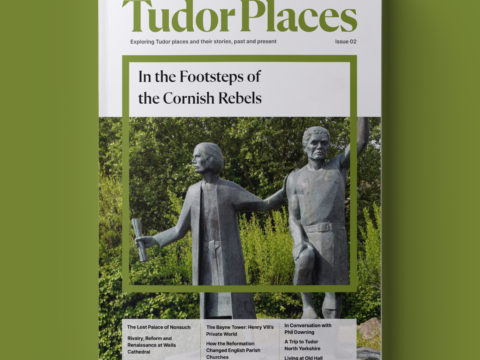Edward Seymour: Life Story
Chapter 3 : The King's Brother-in-Law
Edward was poised to take a senior role at court. Immediately after Queen Jane gave her first official audience to the Imperial ambassador, Chapuys, Edward met him. Jane had received support from many of the courtiers who had disliked the annulment of Henry’s marriage, and the exclusion of his elder daughter, Mary, from the succession and some even hoped for reconciliation with Rome, but, although Jane might have been traditionalist in her religious views, Edward was not. In any event, Jane’s job was to produce a Tudor-Seymour son. Within a week of his sister’s marriage, Edward had been promoted to the peerage as Viscount Beauchamp and was appointed to the privy council soon after Jane announced her pregnancy in spring 1537. When Jane delivered on her side of the royal bargain in October 1537, he became Earl of Hertford. He now also had a family connection to the king’s chief minister – Hertford’s widowed sister, Elizabeth, having married Gregory, the son of Thomas Cromwell in the summer of 1537.
That Jane had borne a boy at her first attempt was lucky not just for the king, but for Hertford. It meant that when she died within two weeks of the birth, the Seymours would remain in favour. Had the child been a girl, or died, the family would probably have been passed over by a subsequent queen’ relatives. Hertford was now firmly in the inner circle, and as uncle to the future king, was a man to be courted.
In early 1539, he sat on the commissions to try a group of nobles in connection with the Exeter Conspiracy. Among them was Sir Nicholas Carew, who had been one of Jane’s greatest supporters but whatever Hertford thought about these men personally, politically, it was positive for him, as they were associated with the pro-Imperial alliance, and Princess Mary. He was also involved with his duties as Governor of Jersey, which involved strengthening the territory against potential French attacks. Later in the summer, he and Anne were hosts to the king at Wolf Hall, as part of the royal summer progress.
At the end of 1539, Hertford was sent to Calais to greet Henry’s new bride, Anne of Cleves. He wrote to Cromwell of his pleasure in the match – the best news, he said, that he had had since the birth of Prince Edward. Unfortunately, the match did not please the king. Cromwell lost his head, and Hertford’s sister, Elizabeth Cromwell, was worried sick that she and her children would suffer in the aftermath. In general, Henry did not visit the crimes of the fathers on the sons, and Gregory Cromwell was retained in royal service.
Whilst Henry’s fourth marriage had pleased Hertford, in part because it indicated an alliance with the Protestant Schmalkaldic League (although Anne of Cleves was not, herself, Lutheran) the king’s fifth marriage, to Katheryn Howard, niece of the Duke of Norfolk was less appealing. Not because he could have had any objection to the queen herself, but because rivalry was growing between the Seymours and the Howards. The duke’s son, Henry Howard, Earl of Surrey, resented the power of the ‘new men’ that is, men who were of gentry status rather than blue-blooded aristocrats like himself. Surrey and Hertford had quarrelled and almost come to a physical altercation in 1537.
Nevertheless, the marriage did not adversely affect Hertford. In 1541, he was elected to the Order of the Garter, one of the most prestigious accolades of the Tudor court. In late summer 1541, Henry VIII, Queen Katheryn and much of the royal court made a progress to York. Hertford remained in London with a core group of councillors, which also included Archbishop Cranmer. Whilst the king was away, Cranmer was informed that Queen Katheryn had been unchaste before her marriage. Unable to decide what to do with such incendiary information, Cranmer consulted Hertford and Lord Chancellor Audley. Since no-one wanted to be the one to tell Henry in person his lovely bride was second-hand goods, the decision was made that Cranmer should write a letter to the king, and leave it in his pew in the chapel at Hampton Court. Predictably, the king was devastated. He ordered rigorous investigation into the allegations, and Hertford was one of those who interrogated the queen’s friends and family, as well as being on the commission that tried the men accused with her, Francis Dereham and Thomas Culpepper. The result was the queen’s execution, and the birth of enmity between the Seymours and the Howards – Katheryn’s cousin, the Earl of Surrey apparently blaming Hertford for bringing the information to the king’s attention. Surrey’s biographer, Jessie Childs, also infers from Surrey’s poetry, that his resentment towards the Seymours may have increased after he had been snubbed by Lady Hertford, perhaps for making sexual advances toward her.
Henry’s marriage to Anne of Cleves had been intended to secure an alliance against the Emperor Charles V when that ruler had overcome years of hostility to ally with France. By 1542, however, the Franco-Imperial détente had collapsed, and the two were again at war. Choosing between the two factions had been the recurring political and military motif of Henry’s reign. He still dreamed of reconquering France, and so once again threw his weight into the Imperial side. He was also spurred on by increased opportunities to meddle in Scotland, traditionally allied with France.



